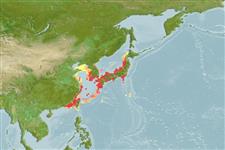Environment: milieu / climate zone / depth range / distribution range
Ecology
Marine; demersal; non-migratory; depth range 0 - 30 m (Ref. 6205). Subtropical; 45°N - 21°N, 116°E - 149°E (Ref. 6205)
Northwest Pacific: Japan, Korea, China, and Taiwan. Possibly to the Philippines. Commonly misidentified as Sillago sihama.
Size / Weight / Age
Maturity: Lm ? range ? - ? cm
Max length : 30.0 cm TL male/unsexed; (Ref. ); common length : 22.0 cm SL male/unsexed; (Ref. 6205)
Dorsal spines (total): 12; Dorsal soft rays (total): 21 - 23; Anal spines: 2; Anal soft rays: 22 - 24; Vertebrae: 35. Swim bladder with anterior projecting extensions and a single posterior extension. Body is greenish gray above, the dorsal part of the head being the darker, and whitish below. The fins are mostly hyaline; the membrane between the first to the third dorsal fin spines with minute dark brown dots; the margins of the dorsal fin with a few dark brown spots. The caudal fin with dark margins.
Occur in bays on shallow sandy flats. Maximum size is over 30 cm (Mark Donachy, pers. comm., 2001). Oviparous (Ref. 205). Greatly esteemed for its delicate flavor (Ref. 6205).
Life cycle and mating behavior
Maturities | Reproduction | Spawnings | Egg(s) | Fecundities | Larvae
McKay, R.J., 1992. FAO Species Catalogue. Vol. 14. Sillaginid fishes of the world (family Sillaginidae). An annotated and illustrated catalogue of the sillago, smelt or Indo-Pacific whiting species known to date. Rome: FAO. FAO Fish. Synop. 125(14):87p. (Ref. 6205)
IUCN Red List Status (Ref. 130435)
Threat to humans
Harmless
Human uses
Fisheries: commercial; aquaculture: likely future use
Tools
Special reports
Download XML
Internet sources
Estimates based on models
Preferred temperature (Ref.
123201): 16.1 - 25.4, mean 21.3 °C (based on 238 cells).
Phylogenetic diversity index (Ref.
82804): PD
50 = 0.5000 [Uniqueness, from 0.5 = low to 2.0 = high].
Bayesian length-weight: a=0.00631 (0.00395 - 0.01009), b=3.05 (2.91 - 3.19), in cm total length, based on LWR estimates for this species & Genus-body shape (Ref.
93245).
Trophic level (Ref.
69278): 3.5 ±0.52 se; based on food items.
Resilience (Ref.
120179): High, minimum population doubling time less than 15 months (Preliminary K or Fecundity.).
Fishing Vulnerability (Ref.
59153): Low vulnerability (20 of 100).
